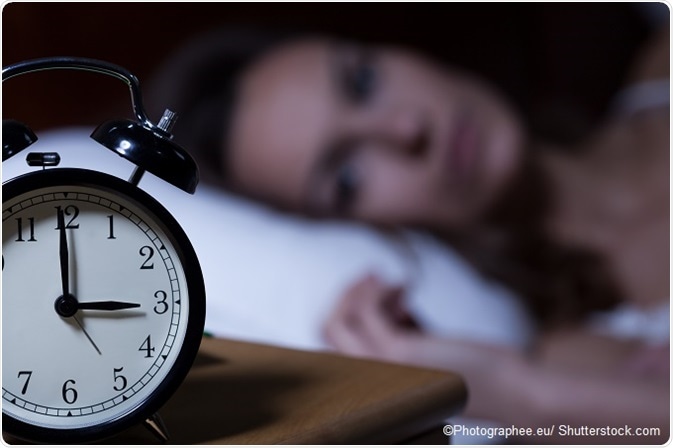Insomnia includes a variety of symptoms, from difficulty in initiating or maintaining sleep to not experiencing good sleep quality. One of the most frequently reported types of insomnia is middle-of-the-night (MOTN) awakenings.

Patients with MOTN typically have no problem dropping off, but awaken after a few hours, and find it hard to go back to sleep. This may eventually cause fear of waking up at night because of the anticipated difficulty of falling back into sleep, and not being able to enjoy unbroken sleep. Almost a fifth of the population has this symptom.
MOTN awakenings occur more often in women, especially in older females. They also tend to smoke, be unemployed, have a middle-class household income, and have other disease conditions.
Reasons for MOTN awakening
Factors that contribute to MOTN insomnia include:
- Poor sleep hygiene
- Sleeping with a noisy or restless partner
- Full bladder presenting the need to void urine
- Noisy or disturbing environment such as keeping the television or music player on while going to sleep
- Exercise or caffeine before bedtime
Once MOTN awakening happens, the person has typically had a few hours of sleep. For this reason, the next bout of sleep may be delayed for an hour or two.
Another reason is an emotional disturbance, especially if someone else is to blame for the patient’s awakening.
Treatment approaches
Cognitive behavioral therapy
Cognitive behavioral therapy (CBT) has been highly effective as a means of treating MOTN awakenings. It is also prolonged in its effects, with good residual changes after therapy ceases.
However, because of the difficulty of obtaining trained personnel for CBT, and the expense of the therapy sessions, it is often not available to patients. For this reason, the first-line treatment is in the form of medication.
Sleep restriction is another component of CBT that has been consistently shown to have profoundly helpful results in MOTN insomnia. Patients must maintain a sleep diary to find out exactly how much of their time they spend sleeping, as compared to the time they are in bed. Once this is known, the time in bed is cut down to only slightly more than the actual sleep time. Other strategies such as trying to keep awake rather than going to sleep, and going to another room not associated with sleep to pursue any quiet activity until one feels sleepy again, are also recommended.
Medication
The most commonly used sleep-inducing drugs are benzodiazepines or GABA-agonists such as zolpidem. They are often chosen for short half-lives, but the fact is that even short-acting drugs produce residual sedation which poses significant safety issues for patients with MOTN awakenings. Delay in reaction times, coordination, and memory issues can have a big negative impact on the way patients live, especially with relation to driving motor vehicles the next morning. Thus, these medications are far from ideal ways to deal with MOTN insomnia.
First and second sleep
Another way to look at sleep is now being discussed. Eminent historian Roger Ekirch has postulated on sociological and historical grounds that human sleep patterns were not always consolidated into one night-time block, as is expected today. Instead, typical pre-industrial societies all over the world had two blocks of sleep, called the first and second sleep, which was not considered pathological.
Instead, the gap of one or two hours between the two was spent in quiet reflection, prayer, handwork of any kind which did not require great effort, or even in sexual relations. The first sleep was usually till about midnight, while the second sleep lasted until dawn. This pattern was not severely affected by seasonal changes in the light period, again suggesting its natural and biological origin. The introduction of electricity and artificial light may have brought about a later sleep onset with less overall sleep and may have been responsible for considering sleep interruptions to be abnormal.
Again, the adoption of a short period of light exposure, for only ten hours a day, brought about a change in sleep patterns into two discontinuous episodes separated by one to three hours. Melatonin secretion and sleepiness also became prolonged in response to the change in the photoperiod.
This knowledge has led some scientists to downplay the significance of MOTN awakening as a sign of insomnia. Individuals with this type of sleep may benefit immensely from sleeping for shorter intervals with a siesta or nap in the afternoons for half an hour or one hour, without delaying their night sleep or shortening it unduly. Another method is to accept the gap as a quiet period for useful occupation, to be followed by another period of restful sleep.
References
-
Ownby, R. (2010) "New approaches in the treatment of short term and middle of the night insomnia: emerging evidence for a role for sublingual zolpidem tablets", Nature and Science of Sleep, p. 63. doi: 10.2147/nss.s5908.
-
Cunnington, D., Junge, M. and Fernando, A. (2013) "Insomnia: prevalence, consequences and effective treatment", Medical Journal of Australia, 199(S8). doi: 10.5694/mja13.10718.
- WEHR, T. (1992) "In short photoperiods, human sleep is biphasic", Journal of Sleep Research, 1(2), pp. 103-107. doi: 10.1111/j.1365-2869.1992.tb00019.x.
Further Reading
Last Updated: Sep 9, 2022